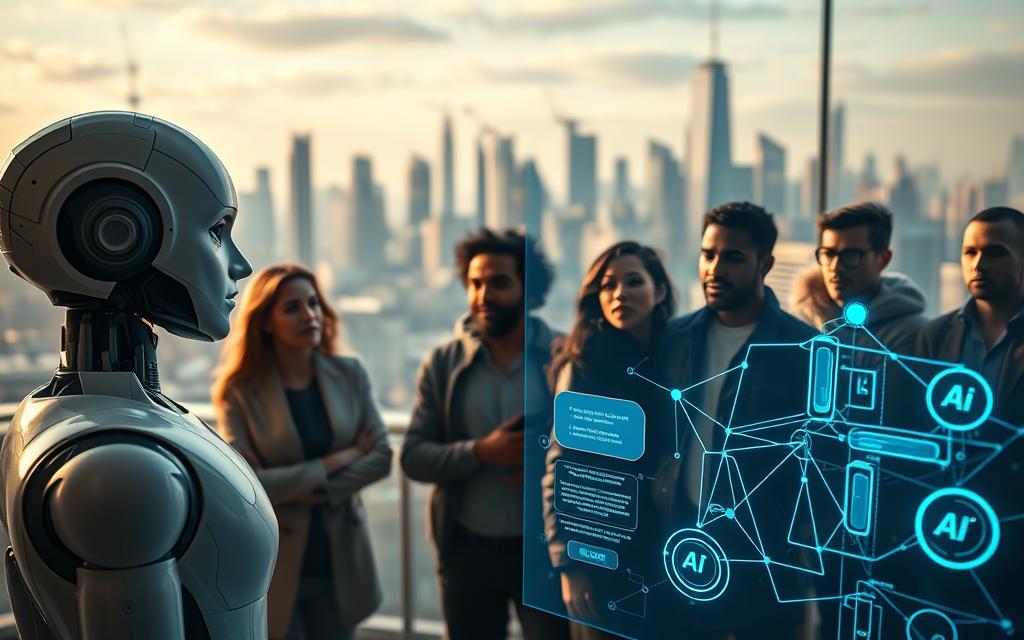Table of Contents
Businesses today face a pivotal moment, much like the Industrial Revolution or the digital age. Technology is reshaping industries at an unprecedented pace, with intelligent systems driving change. By 2025, 82% of enterprises will integrate these advancements, according to recent projections.
Bill Gates once noted, “We’re only at the beginning of what AI can accomplish.” This potential spans operations, customer engagement, and strategic decisions. Amazon already generates 35% of its revenue through automated recommendations.
Small and large firms approach adoption differently, yet both recognize its necessity. The IMF reports 40% of global jobs may adapt to these tools. Staying competitive now means embracing innovation—or risking obsolescence.
The Transformative Role of AI in Modern Business
Modern enterprises no longer view automation as a luxury—it’s a necessity for survival. What began with simple task automation now spans predictive analytics and strategic planning. Artificial intelligence fuels this shift, offering insights that redefine competitiveness.
From Automation to Strategic Decision-Making
Early systems focused on repetitive tasks, like data entry. Today, machine learning analyzes patterns to forecast market trends. A 1980s algorithm processed limited data; 2025 tools process global datasets in seconds.
This evolution creates opportunities for agile businesses. Retailers predict inventory needs, while banks detect fraud before it happens. The key? Leveraging intelligence without losing human oversight.
Dispelling Myths: AI as a Job Transformer, Not a Replacer
Fears of mass job losses ignore history. When digital tools emerged, graphic designers adapted—they didn’t vanish. An MIT study confirms:
“87% of workers using artificial intelligence report enhanced productivity, not replacement.”
Microsoft’s survey reveals a gap: 61% of SMBs lack implementation plans. Upskilling employees bridges this divide. Training programs teach collaboration with smart systems, fostering a new diversity in the workforce.
Enhancing Operational Efficiency with AI
Streamlining operations has become a top priority for companies aiming to stay ahead. Intelligent systems now handle everything from supply chains to financial audits, cutting costs while boosting accuracy. Automation isn’t just about speed—it’s about working smarter.

Automating Repetitive Tasks and Processes
Manual tasks like data entry drain time and resources. Advanced algorithms now complete these processes in minutes. For example, HR departments use smart tools to screen resumes, reducing hiring cycles by 40%.
Wave Accounting’s AI-powered platform scans receipts and detects errors instantly. This eliminates manual reconciliation, saving businesses up to 15 hours weekly. As one CFO noted:
“Automating financial tasks lets our team focus on strategy, not spreadsheets.”
Predictive Analytics for Smarter Inventory Management
Traditional inventory methods often lead to overstocking or shortages. Blue Yonder’s supply chain solutions use analytics to forecast demand with 95% accuracy. Retailers using these tools report 30% fewer stockouts.
| Method | Accuracy | Cost Savings |
|---|---|---|
| Manual Forecasting | 65% | $0 |
| AI-Powered Analytics | 95% | Up to $250K/year |
Manufacturers also benefit. Predictive maintenance reduces equipment downtime by 25%, according to industry reports.
AI-Driven Error Reduction in Financial and Data Systems
Mistakes in financial data cost businesses billions annually. Intelligent systems flag discrepancies in real-time, slashing error rates by 90%. Wave Accounting’s tools, for instance, auto-categorize expenses with 99% precision.
Employees skilled in these processes see tangible rewards. A recent study found a 25% salary premium for professionals mastering automation tools. As analytics evolve, so do opportunities for growth.
For deeper insights on personalizing data-driven strategies, explore AI-powered sales optimization.
Revolutionizing Customer and Employee Experiences
Customer expectations are evolving faster than traditional methods can keep up. Brands now leverage intelligent tools to deliver seamless, personalized interactions. These advancements redefine loyalty and efficiency.
Personalization at Scale: Marketing and Product Recommendations
Algolia’s search tools analyze customer behavior to suggest products in real-time. Retailers using these recommendations see a 35% boost in cross-sales, mirroring Amazon’s success.
Adobe Sensei enhances marketing campaigns by predicting preferences. A skincare brand using Sensei reported a 20% higher click-through rate. Personalization isn’t optional—it’s expected.
| Tool | Use Case | Impact |
|---|---|---|
| Algolia | Product suggestions | +35% revenue |
| Adobe Sensei | Email campaigns | +20% engagement |
AI-Powered Chatbots and 24/7 Customer Support
Chatbots handle 68% of routine inquiries, freeing teams for complex issues. Tidio’s hybrid model blends automation with human escalation, reducing response times by 40%.
Salesforce’s Einstein Bot resolves billing queries in under two minutes. As one service director noted:
“Our customer satisfaction scores jumped 30 points after implementation.”
Sentiment Analysis for Deeper Customer Insights
HubSpot’s CRM tracks social media tone to gauge brand perception. Negative feedback triggers instant alerts, enabling proactive service recovery.
Samsung’s Galaxy S24 Ultra uses sentiment tracking to refine features. Real-time analysis ensures products align with emotional needs, not just technical specs.
AI Tools and Implementation Strategies for Businesses
Selecting the right technologies can make or break a company’s competitive edge. From chatbots to predictive analytics, modern tools cater to diverse needs, whether for startups or multinationals. The key lies in aligning these solutions with specific operational goals.

Top AI Solutions for Small and Large Enterprises
Tidio’s free chatbot plan empowers SMBs with 24/7 customer support, while Blue Yonder’s enterprise systems optimize global supply chains. Here’s how they compare:
| Tool | Best For | Key Feature |
|---|---|---|
| Tidio | SMBs | Free tier, hybrid human-AI chat |
| Blue Yonder | Large enterprises | 95% inventory accuracy |
Google Analytics’ AI-driven traffic predictions help businesses allocate resources smarter. Meanwhile, OpenAI’s GPT-3 aids content creation at scalable pricing tiers.
Steps to Integrate AI: From Needs Assessment to Skill Development
Successful adoption follows five steps:
- Audit existing processes for automation potential.
- Pilot applications like chatbots or sentiment analysis.
- Train teams via programs like CMU’s AI degree.
- Scale technologies company-wide.
- Continuously optimize using feedback loops.
“Graduates of CMU’s program see a 300% ROI within two years.”
Case Study: How E-Commerce Leverages AI for Growth
A mid-sized retailer combined Tidio’s chatbots with Blue Yonder’s inventory systems. Results:
- 40% faster response times.
- 30% reduction in overstock costs.
- 25% higher customer satisfaction scores.
Buffer’s social media tools further amplified their reach, proving the power of integrated applications.
Challenges and Ethical Considerations of AI Adoption
Ethical dilemmas emerge alongside technological advancements in corporate settings. While 71% of employees trust ethically deployed systems, concerns persist about data misuse and job displacement. The Biden administration’s 2023 Executive Order establishes crucial governance frameworks for responsible implementation.
Addressing Data Privacy and Security Concerns
Recent breaches highlight vulnerabilities in automated data handling. The Executive Order mandates:
- Annual security audits for high-risk applications
- Transparent algorithms in hiring tools
- Third-party validation for sensitive operations

Carnegie Mellon’s study revealed gender bias in Google job ads, with tech roles shown 20% more often to male users. This underscores the need for:
“Continuous monitoring of machine learning outputs to prevent discriminatory patterns.”
Bridging the AI Skill Gap in the Workforce
Microsoft reports 67% of SMBs lack internal expertise. Effective solutions include:
| Approach | Impact | Example |
|---|---|---|
| Corporate Academies | 45% faster adoption | Amazon’s ML University |
| Micro-Credentials | 30% salary increase | Google Career Certificates |
These programs create opportunities for career transitions rather than replacements. Hands-on development labs prove particularly effective, with 80% completion rates.
Balancing Automation with Human Oversight
MIT’s decision matrix helps organizations determine which work to automate:
- High-volume repetitive tasks
- Data analysis with clear parameters
- 24/7 customer service queries
Human judgment remains critical for creative problem-solving and ethical reviews. As one Walmart executive noted:
“Our inventory bots reduced errors by 40%, but managers still approve all major supply chain decisions.”
This hybrid approach maintains accountability while leveraging efficiency gains.
Conclusion: The Future of AI in Business
The potential of artificial intelligence continues to reshape industries, with the IMF predicting 60% of advanced economy jobs will adapt to these technologies. By 2026, agentic systems will collaborate with teams, enhancing workflows beyond today’s capabilities.
Microsoft and OpenAI lead democratization efforts, making tools accessible for businesses of all sizes. Samsung’s AI-powered phones showcase real-world integration, from camera enhancements to voice assistants.
For long-term success, companies need a clear roadmap:
- Prioritize pilot projects in high-impact areas
- Invest in continuous development programs
- Balance automation with human creativity
As Bill Gates noted, we’re witnessing the dawn of a transformative era. Staying ahead requires embracing change while addressing ethical considerations. Explore AI business trends for deeper insights.
FAQ
What industries benefit most from artificial intelligence?
Retail, healthcare, finance, and logistics see major gains. Machine learning optimizes supply chains, while chatbots improve customer service. Marketing teams use AI for personalized recommendations.
Can small businesses afford AI technologies?
Yes. Cloud-based solutions like Salesforce Einstein offer scalable pricing. Automation tools for email marketing or inventory management often have free tiers.
How does AI improve customer experiences?
Sentiment analysis tracks feedback across social media. Chatbots handle 80% of routine queries, freeing employees for complex issues. Netflix-style recommendation engines boost sales.
What’s the biggest challenge when implementing AI?
Data quality matters most. Garbage in, garbage out applies to machine learning algorithms. Companies like IBM Watson require clean, structured datasets for accurate insights.
Do companies need data scientists to use AI?
Not always. Platforms like HubSpot provide no-code predictive analytics. However, complex applications in financial modeling or operations may require specialists.
How does AI impact workforce development?
It creates more analytical roles while reducing repetitive tasks. Amazon retrained 300,000 workers for tech positions through its Upskilling 2025 program.
What ethical risks come with AI adoption?
Bias in hiring algorithms and facial recognition systems remains problematic. Microsoft’s Responsible AI Standard provides frameworks for ethical deployment.









